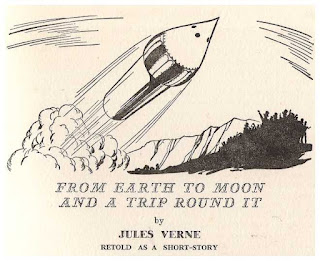I posted about a book from 1948 called Flights Into The Future I'd found at a car-boot sale.
The book contains an abridged version of Jules Verne's From Earth To Moon And A Trip Around It.
Over the next few days I intend serialising the story here.
Jules Verne, famous French pioneer of science-fiction, visualised a voyage to the Moon by means of a projectile shot from an enormous cannon. the "mechanics" of this amazing venture into space may not bear the light of modern scientific knowledge, but the account, given here, in "potted" form, makes fascinating reading and is a remarkable "flight into the future", taken three- quarters of a century ago.
On the first day of December at forty-six minutes and forty seconds after ten p.m., three bold pioneers were shot from the earth to the moon in an aluminium projectile. The three space-travellers were President Barbicane, of the American Gun Club, Captain Nicholl, another American, and Michel Ardan, a Frenchman. Months had been spent in preparation for this amazing adventure, and millions of people were present at the dramatic launching of the Columbaid, which was fired from a gigantic gun sited on Stones Hill, Florida. It was timed to reach the moon at precisely midnight on the fifth day of December, when the moon would be at the zenith, and at it's nearest point to the earth, namely, 238,833 miles.
In something like six seconds the space-shell passed through the deep belt of atmosphere lying above the earth, Barbicane, gazing out through a window into the starlit night, suddenly saw a brilliant disc rushing towards them. It proved to be a meteorite of enormous size, which might easily have ended their experiment there and then by colliding with them. This danger escaped, however, they were able to gaze out in wonder at the heavenly landscape beheld unveiled for the first time by human eye.
The lunar disc shone with wonderful purity. Her rays, no longer filtered through the vapoury atmosphere of the terrestrial globe, shone through the glass, filling the air in the interior of the projectile with silvery reflections. Her mountains, her plains, every projection was as clearly discernible to their eyes as if they were observing it from some spot upon the earth; but it's light was developed through space with wonderful intensity, The disc shone like a platinum mirror. Of the earth flying from under their feet, the travellers had lost all recollection.
The travellers, however, were sharply reminded of the earth, for they discovered that the scientists of Cambridge Observatory, who had calculated that a starting speed of twelve thousand yards was necessary for the projectile to reach the moon, had made a mistake. The impulsion required for the Columbiad to shoot free of the earth's gravitational pull was seventeen thousand yards in the first second.
"We shall not be able to reach the neutral point." said Barbicane.
"The deuce!"
"We shall not even get half way."
"In the name of the projectile!" exclaimed Michel Ardan, jumping as if it was already on the point of striking the terrestrial globe.
"And we shall fall back to earth!"
Continued in tomorrow's thrilling installment!
Wednesday, 25 August 2010
Subscribe to:
Post Comments (Atom)







1 comments:
I read this book somewhere in the years 1949 to 1953. I was quite the Jules Verne fan at the time and I still am. I read it again in the 1960's then again in the 1980's to examine my perspective as adult. I did that to a number of books "Alice in Wonderland" for example. I thought I was an adult in those years now I know I will not live long enough to become an adult.
I was a flight engineer on a Boeing 720 laying over in Portland, Oregon when the TV broadcast of Apollo 8 was orbiting the moon and I shall never forget it. I read it again shortly after.
Thanks for the memories.
Post a Comment